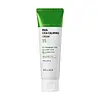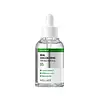What's inside
What's inside
 Key Ingredients
Key Ingredients

 Benefits
Benefits

 Concerns
Concerns

 Ingredients Side-by-side
Ingredients Side-by-side

Water
Skin ConditioningGlycerin
HumectantCaprylic/Capric Triglyceride
MaskingButylene Glycol
HumectantCetearyl Alcohol
EmollientIsotridecyl Isononanoate
EmollientDicaprylyl Ether
Emollient1,2-Hexanediol
Skin ConditioningPentylene Glycol
Skin ConditioningChlorella Vulgaris Extract
Skin ConditioningHydrolyzed Corn Starch
HumectantLactobacillus Ferment
Skin ConditioningSodium Hyaluronate
HumectantCentella Asiatica Leaf Extract
Skin ConditioningDiglycerin
HumectantPolyglyceryl-3 Methylglucose Distearate
EmulsifyingVinyldimethicone
Hydroxyethyl Acrylate/Sodium Acryloyldimethyl Taurate Copolymer
Emulsion StabilisingCetearyl Olivate
Sorbitan Olivate
EmulsifyingPanthenol
Skin ConditioningGlucose
HumectantDiisostearyl Malate
EmollientFructooligosaccharides
HumectantFructose
HumectantSodium Polyacryloyldimethyl Taurate
Emulsion StabilisingPalmitic Acid
EmollientDipropylene Glycol
HumectantStearic Acid
CleansingHydrogenated Polydecene
EmollientEthylhexylglycerin
Skin ConditioningCaprylyl Glycol
EmollientDipotassium Glycyrrhizate
HumectantAdenosine
Skin ConditioningSorbitan Isostearate
EmulsifyingPolyglyceryl-10 Laurate
Skin ConditioningPolyglyceryl-5 Polyricinoleate
EmulsifyingTrisodium Ethylenediamine Disuccinate
Trideceth-10
CleansingHydrogenated Lecithin
EmulsifyingSodium Stearoyl Glutamate
CleansingLecithin
EmollientSucrose
HumectantMadecassoside
AntioxidantTocopherol
AntioxidantAsiaticoside
AntioxidantMadecassic Acid
Skin ConditioningAsiatic Acid
Skin ConditioningXanthan Gum
EmulsifyingWater, Glycerin, Caprylic/Capric Triglyceride, Butylene Glycol, Cetearyl Alcohol, Isotridecyl Isononanoate, Dicaprylyl Ether, 1,2-Hexanediol, Pentylene Glycol, Chlorella Vulgaris Extract, Hydrolyzed Corn Starch, Lactobacillus Ferment, Sodium Hyaluronate, Centella Asiatica Leaf Extract, Diglycerin, Polyglyceryl-3 Methylglucose Distearate, Vinyldimethicone, Hydroxyethyl Acrylate/Sodium Acryloyldimethyl Taurate Copolymer, Cetearyl Olivate, Sorbitan Olivate, Panthenol, Glucose, Diisostearyl Malate, Fructooligosaccharides, Fructose, Sodium Polyacryloyldimethyl Taurate, Palmitic Acid, Dipropylene Glycol, Stearic Acid, Hydrogenated Polydecene, Ethylhexylglycerin, Caprylyl Glycol, Dipotassium Glycyrrhizate, Adenosine, Sorbitan Isostearate, Polyglyceryl-10 Laurate, Polyglyceryl-5 Polyricinoleate, Trisodium Ethylenediamine Disuccinate, Trideceth-10, Hydrogenated Lecithin, Sodium Stearoyl Glutamate, Lecithin, Sucrose, Madecassoside, Tocopherol, Asiaticoside, Madecassic Acid, Asiatic Acid, Xanthan Gum
Water
Skin ConditioningButylene Glycol
Humectant1,2-Hexanediol
Skin ConditioningNiacinamide
SmoothingDipropylene Glycol
HumectantGlycerin
HumectantDimethyl Sulfone
SolventHydrogenated Lecithin
EmulsifyingSodium Hyaluronate
HumectantAllantoin
Skin ConditioningBiosaccharide Gum-1
HumectantDisodium EDTA
Ethylhexylglycerin
Skin ConditioningGluconolactone
Skin ConditioningLactobacillus Ferment
Skin ConditioningLecithin
EmollientMadecassoside
AntioxidantPanthenol
Skin ConditioningPentylene Glycol
Skin ConditioningPolyglyceryl-10 Laurate
Skin ConditioningPolyglyceryl-5 Polyricinoleate
EmulsifyingPropanediol
SolventSalicylic Acid
MaskingSodium Polyacryloyldimethyl Taurate
Emulsion StabilisingSodium Stearoyl Glutamate
CleansingWater, Butylene Glycol, 1,2-Hexanediol, Niacinamide, Dipropylene Glycol, Glycerin, Dimethyl Sulfone, Hydrogenated Lecithin, Sodium Hyaluronate, Allantoin, Biosaccharide Gum-1, Disodium EDTA, Ethylhexylglycerin, Gluconolactone, Lactobacillus Ferment, Lecithin, Madecassoside, Panthenol, Pentylene Glycol, Polyglyceryl-10 Laurate, Polyglyceryl-5 Polyricinoleate, Propanediol, Salicylic Acid, Sodium Polyacryloyldimethyl Taurate, Sodium Stearoyl Glutamate
Ingredients Explained
These ingredients are found in both products.
Ingredients higher up in an ingredient list are typically present in a larger amount.
1,2-Hexanediol is a synthetic liquid and another multi-functional powerhouse.
It is a:
- Humectant, drawing moisture into the skin
- Emollient, helping to soften skin
- Solvent, dispersing and stabilizing formulas
- Preservative booster, enhancing the antimicrobial activity of other preservatives
Butylene Glycol (or BG) is used within cosmetic products for a few different reasons:
Overall, Butylene Glycol is a safe and well-rounded ingredient that works well with other ingredients.
Though this ingredient works well with most skin types, some people with sensitive skin may experience a reaction such as allergic rashes, closed comedones, or itchiness.
Learn more about Butylene GlycolDipropylene Glycol is a synthetically created humectant, stabilizer, and solvent.
This ingredient helps:
Dipropylene glycol is technically an alcohol, but it belongs to the glycol family (often considered part of the ‘good’ alcohols). This means it is hydrating and gentle on skin unlike drying solvent alcohols like denatured alcohol.
As a masking agent, Dipropylene Glycol can be used to cover the smell of other ingredients. However, it does not have a scent.
Studies show Dipropylene Glycol is considered safe to use in skincare.
Learn more about Dipropylene GlycolEthylhexylglycerin (we can't pronounce this either) is commonly used as a preservative and skin softener. It is derived from glyceryl.
You might see Ethylhexylglycerin often paired with other preservatives such as phenoxyethanol. Ethylhexylglycerin has been found to increase the effectiveness of these other preservatives.
Glycerin is already naturally found in your skin. It helps moisturize and protect your skin.
A study from 2016 found glycerin to be more effective as a humectant than AHAs and hyaluronic acid.
As a humectant, it helps the skin stay hydrated by pulling moisture to your skin. The low molecular weight of glycerin allows it to pull moisture into the deeper layers of your skin.
Hydrated skin improves your skin barrier; Your skin barrier helps protect against irritants and bacteria.
Glycerin has also been found to have antimicrobial and antiviral properties. Due to these properties, glycerin is often used in wound and burn treatments.
In cosmetics, glycerin is usually derived from plants such as soybean or palm. However, it can also be sourced from animals, such as tallow or animal fat.
This ingredient is organic, colorless, odorless, and non-toxic.
Glycerin is the name for this ingredient in American English. British English uses Glycerol/Glycerine.
Learn more about GlycerinHydrogenated Lecithin is created from the hydrogenation of lecithin (a group of phospholipids). Hydrogenation is a chemical reaction between hydrogen and another element.
This ingredient is an emollient and emulsifier. As an emollient, it helps soften skin by trapping moisture within. As an emulsifier, it prevents oil and water ingredients from separating.
Lactobacillus Ferment is created by fermenting the Lactobacillus bacteria. It helps keep our skin's natural barrier and microbiome healthy.
Studies show lactobacillus ferment to be effective at repairing the skin barrier. Having a healthy skin barrier helps keep your skin healthy and hydrated. It also protects against bad bacteria.
As a probiotic/prebiotic/postbiotic, Lactobacillus ferment can help regular our natural biome. In fact, one study found a lack of diversity in our natural skin biome can trigger acne.
Learn more about Lactobacillus FermentLecithin is a term for a group of substances found in the cell membranes of plants, animals, and humans. They are made up of mixture of phospholipids.
This ingredient has emollient and emulsifying properties.
As an emollient, lecithen helps soften the skin and creates a barrier to keep moisture in.
As an emulsifier, it also helps prevent water and oil ingredients from separating. Lecithin can also help ingredients be better absorbed by the skin.
This is because the phospholipids in lecithin produce liposomes. Liposomes help other ingredients get through the skin barrier.
Depending on the source of this ingredient, lecithin may not be fungal acne safe. This is because some sources of lecithin come from soybean oil, which may feed the malassezia yeast that feeds fungal acne.
We recommend reaching out to the brand you are purchasing from to inquire about the source of their lecithin.
Some other names for this ingredient include soy lecithin and deoiled soy lecithin.
Learn more about LecithinMadecassoside comes from the super popular skin-soothing ingredient, Centella asiatica. It is one of four active compounds found in the extract of Centella Asiatica.
Madecassoside has antioxidant, anti-inflammatory, and hydrating properties. It contains fatty acids, amino acids, beta-carotene, and phytochemicals.
One study found using Madecassoside with ascorbic acid helped reduce the signs of aging and improved skin hydration.
Learn more about MadecassosidePanthenol is a common ingredient that helps hydrate and soothe the skin. It is found naturally in our skin and hair.
There are two forms of panthenol: D and L.
D-panthenol is also known as dexpanthenol. Most cosmetics use dexpanthenol or a mixture of D and L-panthenol.
Panthenol is famous due to its ability to go deeper into the skin's layers. Using this ingredient has numerous pros (and no cons):
Like hyaluronic acid, panthenol is a humectant. Humectants are able to bind and hold large amounts of water to keep skin hydrated.
This ingredient works well for wound healing. It works by increasing tissue in the wound and helps close open wounds.
Once oxidized, panthenol converts to pantothenic acid. Panthothenic acid is found in all living cells.
This ingredient is also referred to as pro-vitamin B5.
Learn more about PanthenolPentylene glycol is typically used within a product to thicken it. It also adds a smooth, soft, and moisturizing feel to the product. It is naturally found in plants such as sugar beets.
The hydrophilic trait of Pentylene Glycol makes it a humectant. As a humectant, Pentylene Glycol helps draw moisture from the air to your skin. This can help keep your skin hydrated.
This property also makes Pentylene Glycol a great texture enhancer. It can also help thicken or stabilize a product.
Pentylene Glycol also acts as a mild preservative and helps to keep a product microbe-free.
Some people may experience mild eye and skin irritation from Pentylene Glycol. We always recommend speaking with a professional about using this ingredient in your routine.
Pentylene Glycol has a low molecular weight and is part of the 1,2-glycol family.
Learn more about Pentylene GlycolPolyglyceryl-10 Laurate is an ester of lauric acid and Polyglycerin-10.
Polyglyceryl-10 Laurate is a cleansing agent and emulsifier. It helps gather dirt, oil, and other pollutants to be rinsed away. As an emulsifier, it helps prevent ingredients from separating, such as oil and water.
Polyglyceryl-10 Laurate may not be fungal acne safe.
Learn more about Polyglyceryl-10 LauratePolyglyceryl-5 Polyricinoleate isn't fungal acne safe.
Sodium Hyaluronate is hyaluronic acid's salt form. It is commonly derived from the sodium salt of hyaluronic acid.
Like hyaluronic acid, it is great at holding water and acts as a humectant. This makes it a great skin hydrating ingredient.
Sodium Hyaluronate is naturally occurring in our bodies and is mostly found in eye fluid and joints.
These are some other common types of Hyaluronic Acid:
Learn more about Sodium HyaluronateSodium Polyacryloyldimethyl Taurate is a polymer and used to help stabilize other ingredients.
Emulsion stabilizers hold ingredients together, helping to create an even texture throughout the product.
Sodium Polyacryloyldimethyl Taurate can also be used to thicken the texture.
Learn more about Sodium Polyacryloyldimethyl TaurateSodium Stearoyl Glutamate is an emulsifier and helps condition the skin. It is amino acid-based.
In higher amounts, it may act as a cleansing agent.
Water. It's the most common cosmetic ingredient of all. You'll usually see it at the top of ingredient lists, meaning that it makes up the largest part of the product.
So why is it so popular? Water most often acts as a solvent - this means that it helps dissolve other ingredients into the formulation.
You'll also recognize water as that liquid we all need to stay alive. If you see this, drink a glass of water. Stay hydrated!
Learn more about Water